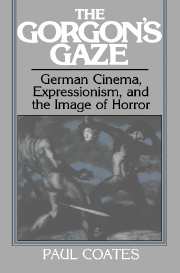Book contents
- Frontmatter
- Contents
- Preface
- Acknowledgments
- Introduction: The uncanny and the gorgon's gaze
- I Silent cinema and expressionism
- II The sleep of reason: Monstrosity and disavowal
- III Memory and repression in recent German cinema
- IV Expressionism in America
- V Elective affinities and family resemblances: For Margarethe von Trotta
- Appendixes
- 1 Melodrama contra the fantastic: Petro, Elsaesser, and Sirk
- 2 Early cinema, surrealism, and allegory
- 3 Modernism and the body as machine
- 4 The articulation of guilt in Broch's Der Versucher
- 5 Film noir, Macbeth, and murdered sleep
- 6 Dissolving the fear of the feminine: Wim Wenders
- Notes
- Selected bibliography
- Filmography
- Index
5 - Film noir, Macbeth, and murdered sleep
Published online by Cambridge University Press: 21 October 2009
- Frontmatter
- Contents
- Preface
- Acknowledgments
- Introduction: The uncanny and the gorgon's gaze
- I Silent cinema and expressionism
- II The sleep of reason: Monstrosity and disavowal
- III Memory and repression in recent German cinema
- IV Expressionism in America
- V Elective affinities and family resemblances: For Margarethe von Trotta
- Appendixes
- 1 Melodrama contra the fantastic: Petro, Elsaesser, and Sirk
- 2 Early cinema, surrealism, and allegory
- 3 Modernism and the body as machine
- 4 The articulation of guilt in Broch's Der Versucher
- 5 Film noir, Macbeth, and murdered sleep
- 6 Dissolving the fear of the feminine: Wim Wenders
- Notes
- Selected bibliography
- Filmography
- Index
Summary
Is there any significance in the fact that the two finest Western directors to have made versions of Macbeth – Polanski and Welles – should also have made a film noir piece (The Lady from Shanghai and Chinatown) about the same time as their Macbeth? Or that these two films noirs lack many of the traditional elements of the genre, while retaining what to my mind is the keystone of noir ideology, the image of the threatening female – an image that also dominates Macbeth? These may be merely random thematic and biographical echoes. But are they?
The fundamental noir scenario is one in which a wife plots with her lover to murder her husband, who is usually a much older man: Double Indemnity and The Postman Always Rings Twice are the prototypes, fused in pastiche in Kasdan's Body Heat. This scenario is only tangentially present in The Lady from Shanghai and Chinatown; the reason, I suspect, being that Welles and Polanski had already filmed an alternative version of it, Macbeth. Macbeth has every appearance of being a garbled account of a myth of kingly succession in a matriarchal society: The Queen disposes of the old priest-king (Duncan), who is no longer referred to as her consort since he can in fact no longer satisfy her, and she appoints a younger man to take his place (the rite de passage he undergoes to prove his suitability for this role is the murder of the old king).
- Type
- Chapter
- Information
- The Gorgon's GazeGerman Cinema, Expressionism, and the Image of Horror, pp. 246 - 248Publisher: Cambridge University PressPrint publication year: 1991



